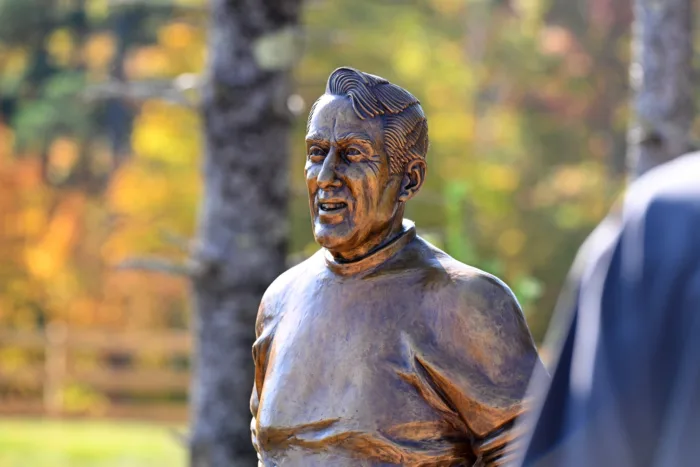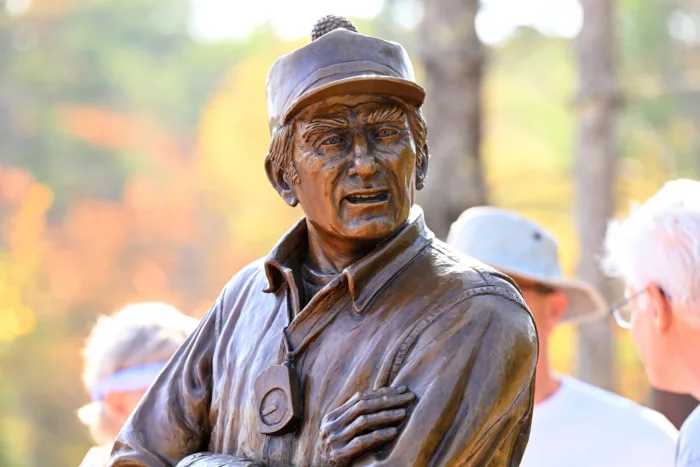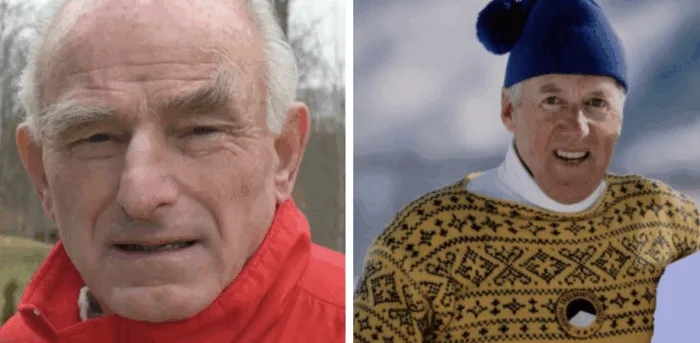Birkebeiner Trail statues unveiled to honor designers Sven Wiik, Marty Hall


Dedication ceremony held Oct. 4 at trailhead near Cable, Wis.
CABLE, Wis. — In 1975 and 1976, Sven Wiik and Marty Hall were hired, respectively, to design the American Birkebeiner cross-country ski trail.
Fifty years later, on Oct. 4, at the race trailhead near Cable, they were honored posthumously when life-size statues of them were unveiled. A crowd of about 100 people, including families of both men, gathered for a dedication program and unveiling.
Over the past half-century, the trail, brainchild of Telemark Lodge owner Tony Wise, has been recognized as one of the finest in the world for competition and recreation and has helped spur growth of the race.

“These two gentlemen turned Tony Wise’s vision into reality. They designed a trail that has helped define the Birkebeiner and has meant so much to generations of skiers,” said Ben Popp, executive director of the American Birkebeiner Ski Foundation. “We’re pleased to honor their historic contributions to the race and the sport of cross country skiing.”
Since its inception, the 50-kilometer trail from Cable to Hayward is estimated to have been used by more than 1 million people, Popp said.
Birgitta Wiik, daughter of Sven, unveiled the statue of her father, with Sven’s wife, Birthe, and granddaughter, Kajsa Wiik-Lindgren, looking on. Kathy Hall, wife of Marty, unveiled his statue.
Numerous friends and family members of the men from around the U.S. and Canada attended.
“We remember Sven not only as a being a trail designer but also as a beloved coach, mentor and an inspirational figure who dedicated his life to igniting a passion for skiing in the hearts of countless individuals over many decades,” Birgitta said.
Sven Wiik, a native of Sweden who lived in Colorado, and Marty Hall, from New Hampshire, were former U.S. Olympic coaches and are members of the U.S. Ski and Snowboard Hall of Fame.
Wiik died in 2016, and Hall died in February 2025.
“The statues here today capture the creation of the American Birkebeiner Trail,” Kathy Hall said, citing how her husband’s 1976 U.S. Olympic team trained at Telemark and sparked a friendship with Wise that brought Marty back that spring to finish the design that Sven Wiik had begun.
“Marty and Tony were kindred spirits. Marty spent time at Telemark with Tony, where they hatched a bigger future of cross-country racing at Telemark,” she said.
Prior to mapping the Birkebeiner Trail, Sven Wiik designed the very first cross country trails at Telemark Lodge. After working on the race trail, Marty Hall designed World Cup and other trails at Telemark and helped with trail widening in 1979.
The life-size statues are next to each other, separated by plaques highlighting the men’s contributions to the trail and to the sport. A third plaque chronicles trail history.
Jerome Poling, who wrote the plaques and a forthcoming book on Birkebeiner history, “America’s Greatest Ski Marathon,” spoke at the dedication and said the trail ushered in a new era of race history.
“Sven and Marty were Nordic skiing pioneers in so many ways, one in the West one in the East. They truly loved this then-fledgling sport in the U.S. and were committed — like Tony — to helping push cross country skiing forward,” Poling said.
“Help they did. The Birkebeiner is the third largest ski marathon in the world. From 324 skiers in 1975 to more than 10,000 skiers. Without this iconic trail, the American Birkebeiner would not be the famous Birkie today,” he said.
Sven Wiik and Marty Hall also skied in many Birkebeiners on the trail they designed.
The project was approved by the American Birkebeiner Ski Foundation, with fundraising coordinated by the families.
The statues were designed and sculpted by multimedia artist Tom Holleran of Milwaukee and cast at Vanguard Sculpture Services in Milwaukee.
The families of both men contributed to the designs by working with Holleran and Vanguard to describe how they would like Wiik and Hall to be portrayed. Hall contributed to the design of his sculpture.
“Both families were very encouraging throughout the whole process,” said Holleran, who attended the event.
Holleran spent months working on each statue to depict not just the men’s likeness but how they would be presented, Wiik with a saw marching through the woods and Hall with his arms crossed representing his many years as a coach but also carrying trail-marking tools.
Also speaking at the dedication were Ernie St. Germaine, the only skier to have completed 50 Birkebeiners, who provided an Ojibwe blessing; and Frances Wise, daughter of Tony Wise.
Special attendees included Don Quinn, runner-up in the second Birkebeiner who was coached by Wiik in college; Alison Kiesel (formerly Owen-Spencer), former U.S. Olympian coached by Hall; Doug Peterson, former U.S. Olympian coached by Hall; Peter Davis, former Telemark Academy director; John Kotar, Birkebeiner founding skier; and Duncan McLean, longtime Birkebeiner entrant and winner of the first Kortelopet.
Fundraising is underway for a third statue, of Wise, to be placed at the site of the former Telemark Lodge. The lodge was razed in 2021, and the Birkebeiner Foundation began redeveloping the site now known as Mt. Telemark Village.
###
Posted October 7, 2025 at 11:29 am


